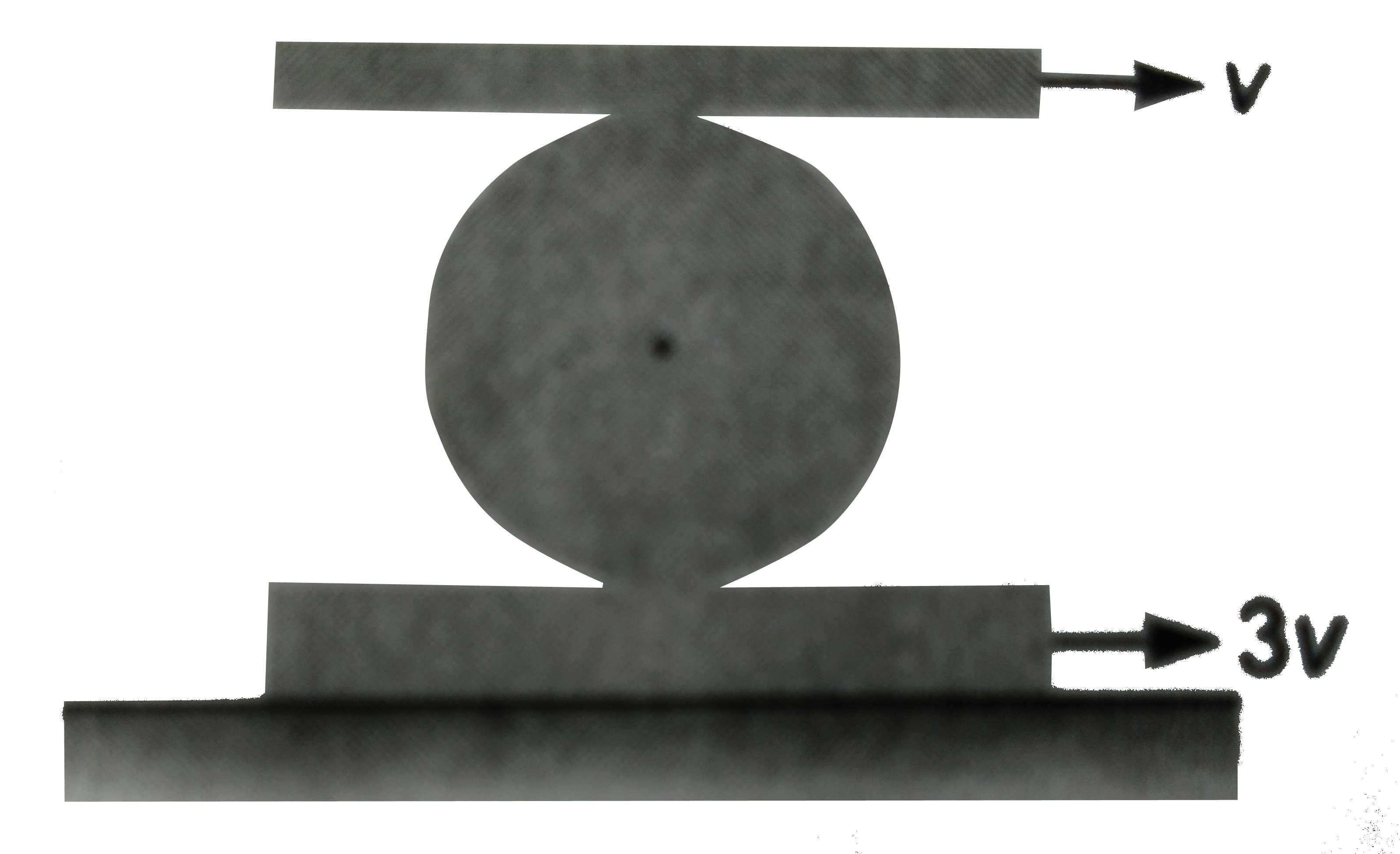A cylinder of radius R and mass M rolls without slipping down a plane inclined at an angle θ. Coeff. of friction between the cylinder and the plane is μ. For what maximum inclination θ, the cylinder rolls without slipping ?
tanθ gt 3μs
tanθ ≤ 3μs
tanθ lt 3μs
None of these
The correct Answer is:b
To solve the problem of determining the maximum inclination angle θ at which a cylinder rolls without slipping down an inclined plane, we will follow these steps:
Step 1: Identify Forces Acting on the Cylinder
When the cylinder rolls down the inclined plane, the forces acting on it are:
- The gravitational force Mg acting vertically downward.
- The component of gravitational force acting down the incline: Mgsinθ.
- The normal force N acting perpendicular to the incline.
- The frictional force f acting up the incline, which prevents slipping.
Step 2: Write the Equations of Motion
For translational motion along the incline, we can write the equation:
Mgsinθ−f=Ma
where a is the linear acceleration of the center of mass of the cylinder.
For rotational motion, the torque τ about the center of mass due to friction is given by:
τ=f⋅R
This torque causes an angular acceleration α given by:
τ=Iα
For a solid cylinder, the moment of inertia I is:
I=12MR2
Using the relationship between linear acceleration a and angular acceleration α:
a=Rα⟹α=aR
We can substitute this into the torque equation:
f⋅R=12MR2⋅aR
This simplifies to:
f=12Ma
Step 3: Substitute Friction into the Translational Motion Equation
From the friction equation, we have:
f=μN
The normal force N can be expressed as:
N=Mgcosθ
Thus, we can write:
f=μMgcosθ
Now substituting this expression for f into the translational motion equation:
Mgsinθ−μMgcosθ=Ma
Step 4: Eliminate Mass and Rearrange
Dividing through by M gives:
gsinθ−μgcosθ=a
Now substituting a from the rotational motion equation:
gsinθ−μgcosθ=12a
Replacing a with 2f:
gsinθ−μgcosθ=12⋅12Ma
This leads to:
gsinθ−μgcosθ=12⋅12⋅μgcosθ
Step 5: Solve for θ
Rearranging gives:
gsinθ=μgcosθ+12μgcosθ
This simplifies to:
gsinθ=32μgcosθ
Dividing through by g (assuming g≠0):
sinθ=32μcosθ
Dividing both sides by cosθ:
tanθ=32μ
Thus, the maximum angle θ for which the cylinder rolls without slipping is:
θ=tan−1(32μ)
Final Answer
The maximum inclination angle θ at which the cylinder rolls without slipping is:
θ=tan−1(32μ)
When the cylinder rolls down the inclined plane, the forces acting on it are:
- The gravitational force Mg acting vertically downward.
- The component of gravitational force acting down the incline: Mgsinθ.
- The normal force N acting perpendicular to the incline.
- The frictional force f acting up the incline, which prevents slipping.
For translational motion along the incline, we can write the equation:
Mgsinθ−f=Ma
where a is the linear acceleration of the center of mass of the cylinder.
τ=f⋅R
This torque causes an angular acceleration α given by:
τ=Iα
For a solid cylinder, the moment of inertia I is:
I=12MR2
Using the relationship between linear acceleration a and angular acceleration α:
a=Rα⟹α=aR
We can substitute this into the torque equation:
f⋅R=12MR2⋅aR
This simplifies to:
f=12Ma
From the friction equation, we have:
f=μN
The normal force N can be expressed as:
N=Mgcosθ
Thus, we can write:
f=μMgcosθ
Now substituting this expression for f into the translational motion equation:
Mgsinθ−μMgcosθ=Ma
Dividing through by M gives:
gsinθ−μgcosθ=a
Now substituting a from the rotational motion equation:
gsinθ−μgcosθ=12a
Replacing a with 2f:
gsinθ−μgcosθ=12⋅12Ma
This leads to:
gsinθ−μgcosθ=12⋅12⋅μgcosθ
Rearranging gives:
gsinθ=μgcosθ+12μgcosθ
This simplifies to:
gsinθ=32μgcosθ
Dividing through by g (assuming g≠0):
sinθ=32μcosθ
Dividing both sides by cosθ:
tanθ=32μ
Thus, the maximum angle θ for which the cylinder rolls without slipping is:
θ=tan−1(32μ)
The maximum inclination angle θ at which the cylinder rolls without slipping is:
θ=tan−1(32μ)
Topper's Solved these Questions
- SYSTEM OF PARTICLES AND ROTATIONAL MOTIONSBOOK - NCERT FINGERTPS ENGLISHCHAPTER - SYSTEM OF PARTICLES AND ROTATIONAL MOTIONSEXERCISE - HOTS HIGHER ORDER THINKING SKILL
8 Videos
- SYSTEM OF PARTICLES AND ROTATIONAL MOTIONSBOOK - NCERT FINGERTPS ENGLISHCHAPTER - SYSTEM OF PARTICLES AND ROTATIONAL MOTIONSEXERCISE - NCER EXAMPLAR PROBLEMS
8 Videos
- SYSTEM OF PARTICLES AND ROTATIONAL MOTIONSBOOK - NCERT FINGERTPS ENGLISHCHAPTER - SYSTEM OF PARTICLES AND ROTATIONAL MOTIONSEXERCISE - ANGULAR MOMENTUM IN CASE OF ROTATIONS ABOUT A FIXED AXIS
16 Videos
- PRACTICE PAPERSBOOK - NCERT FINGERTPS ENGLISHCHAPTER - PRACTICE PAPERSEXERCISE - All Questions
150 Videos
- THERMAL PROPERTIES OF MATTERBOOK - NCERT FINGERTPS ENGLISHCHAPTER - THERMAL PROPERTIES OF MATTEREXERCISE - Assertion And Reason
10 Videos
Similar Questions
Knowledge Check
A solid cylinder of mass M and radius R rolls without slipping down an inclined plane making an angle 6 with the horizontal. Then its acceleration is.
A1/3 g sinθB2/3 g sinθC2/5 g sinθD2/7 g sinθ
A hollow sphere rolls without slipping down a plane inclined at an angle of 30° to the horizontal. Its linear acceleration will be
View SolutionA solid uniform disc of mass m rolls without slipping down a fixed inclined plank with an acceleration a. The frictional force on the disc due to surface of the plane is
View SolutionA rolling object rolls without slipping down an inclined plane (angle of inclination θ), then the minimum acceleration it can have is ?
View SolutionA solid sphere of mass m rolls without slipping on an inclined plane of inclination θ. The linear acceleration of the sphere is
View SolutionA solid cylinder of mass M and radius R rolls without slipping on a flat horizontal surface. Its moment of inertia about the line of contact is
View SolutionA solid cylinder of mass M and radius R rolls without slipping down an inclined plane of length L and height h. What is the speed of its center of mass when the cylinder reaches its bottom
View SolutionA solid cylinder is rolling without slipping on a plane having inclination θ and the coefficient of static friction μs. The relation between θ and μs is
View Solution
